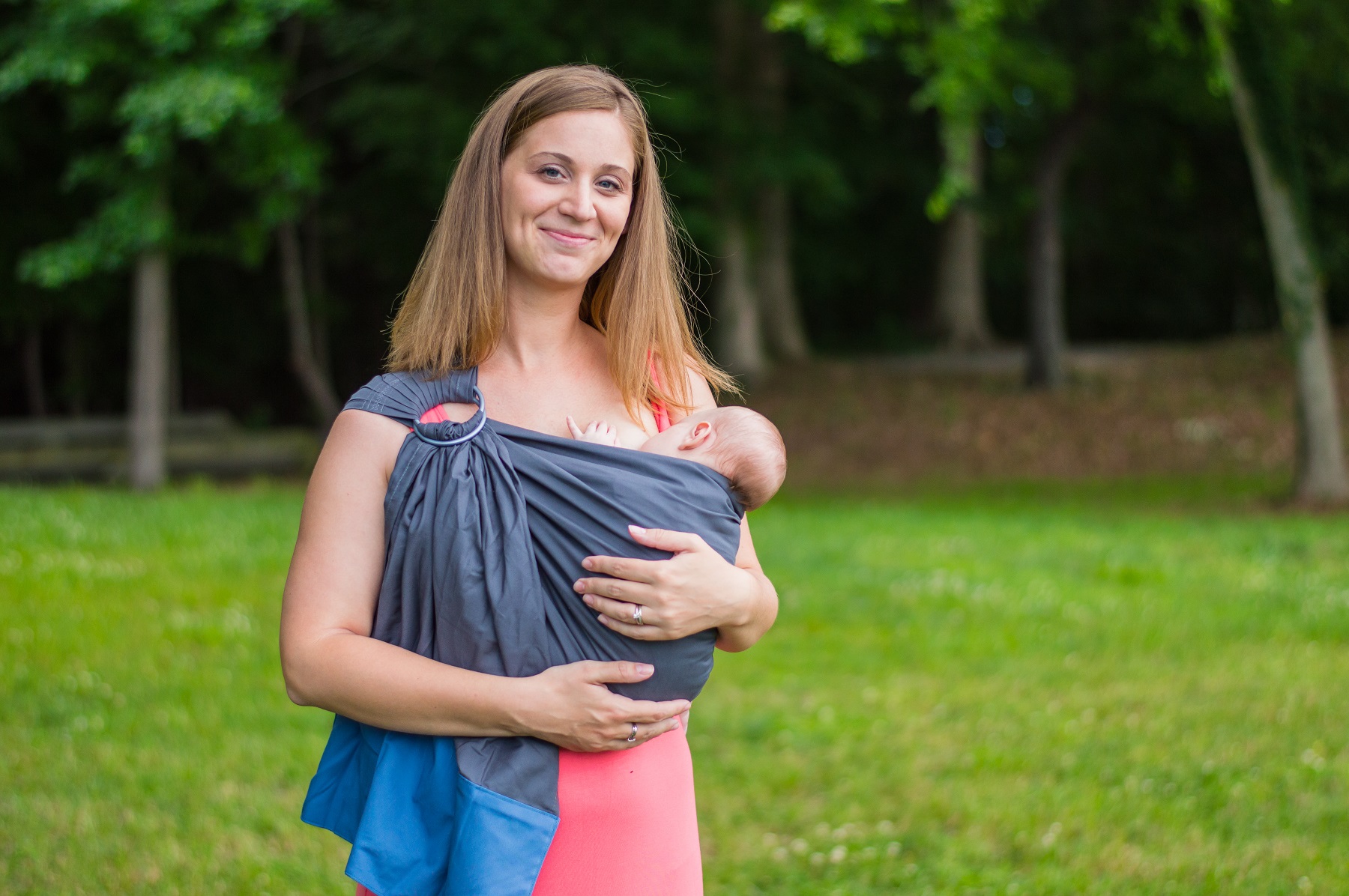Advanced positionPartial recline / cradle hold:
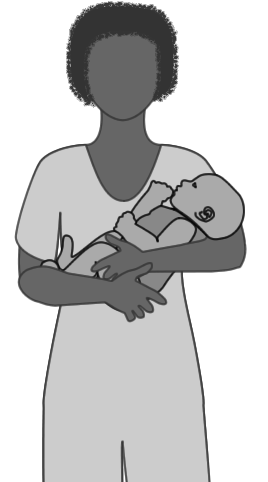 Particular caution needs to be taken with this position. Your baby should never be hidden deep in the fabric. Before using this hold in a sling, cradle your baby in your arms as feels natural to you, and look in the mirror to see how they are positioned. The sling should support your baby in the same way, with the baby's body diagonally inclined and their head clear of the fabric so that their chin isn't forced onto their chest. Even when just holding the baby, you should be able to get at least two fingers between the baby’s chin and chest. In any position, you should always be able to clearly see their mouth and nose for safety.
Particular caution needs to be taken with this position. Your baby should never be hidden deep in the fabric. Before using this hold in a sling, cradle your baby in your arms as feels natural to you, and look in the mirror to see how they are positioned. The sling should support your baby in the same way, with the baby's body diagonally inclined and their head clear of the fabric so that their chin isn't forced onto their chest. Even when just holding the baby, you should be able to get at least two fingers between the baby’s chin and chest. In any position, you should always be able to clearly see their mouth and nose for safety.
Important: Grunting and snoring noises that occur only in this position are a sign that the baby is having trouble breathing and should be repositioned at once. Always remember that your baby's airway needs to be straight: her chin should never rest on her chest in any situation (including in other devices, like carseats and bouncers).
For: newborn to toddler
Preparation: Decide which side you want the baby’s head to rest on. If you are petite, you will likely have an easier time with their head on the side opposite the rings. If your torso is wide enough, you may have their head on the same side as the rings; however, a ring-side cradle hold is not as safe as the opposite, since the fabric, drawn up to the rings, may force your baby's head forward onto their chest. The technique below is similar for the cradle hold with the baby's head on the same side as the rings, but you will want to start with their head at least 4" from the rings, to avoid having the rings touch they baby’s head when the sling is fully adjusted. It's easier to do a semi-sitting position with their head on the ring side than on the opposite side, once they’re old enough to hold up their head.
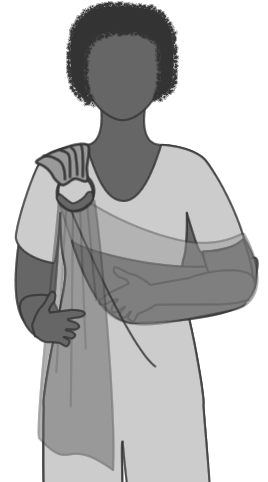
Make a pouch with the body of the sling. Put the sling on as you normally would, and then pull the lower edge upwards on your chest so that you've formed a shallow pouch with the fabric. You'll want the lower edge (now the inside edge) to be nice and tight, so pull on the outside edge of the tail.
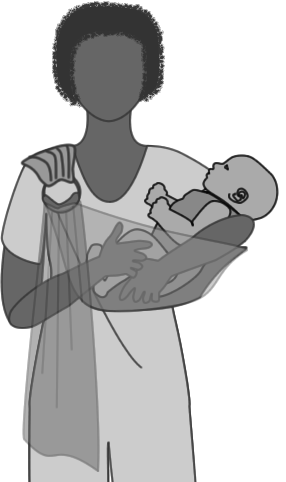
Cradle your baby with the arm opposite the rings, just as you would if you weren't wearing the sling. Open the sling with your "ring" hand, and slip the baby into the pouch with your arm still around him. Support his head if he is a newborn.
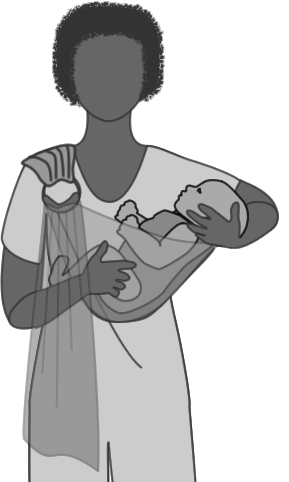
Continue to support their head, and slowly slip your arm out from underneath them. You can use your other hand to support their body if this step makes you nervous, but the pouch of the sling will support the baby’s weight. Now you can tighten the sling fully.
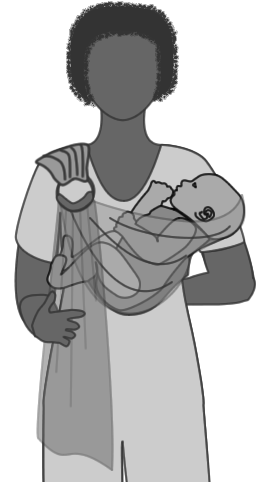
You will need to tighten the upper and lower edges -- and even the body of the sling -- independently, by respectively pulling the inner, outer, and center portions of the tail in turn. If the sling is difficult to adjust, you can hold the rings apart slightly with one hand, while pulling with the other. The closer you are to this final step in step one, the easier it will be to make the sling feel secure.
Nursing in the cradle hold:
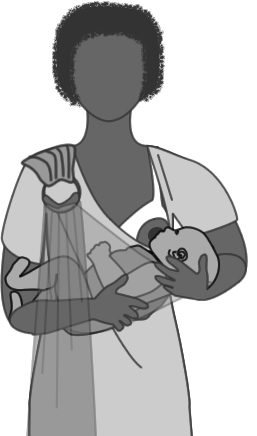 Experts agree that it’s easiest to learn to nurse, and then learn to nurse in a sling. Nursing a newborn hands-free is not recommended: it is tricky to control how snug the sling is, and one can easily push the baby’s face into the breast and cut off air flow.
Experts agree that it’s easiest to learn to nurse, and then learn to nurse in a sling. Nursing a newborn hands-free is not recommended: it is tricky to control how snug the sling is, and one can easily push the baby’s face into the breast and cut off air flow.
Rest the baby’s head in the crook of your elbow to position the baby, as you would without the sling, as a good reminder to move their back to an upright position when they’re done nursing. You’ll have one hand free, which is better than none, and it’s safer than trying hands-free before your baby is ready.
Pull the sling around the baby, so that their feet stick out the side. (Tiny infants may keep their feet in the sling, but will quickly outgrow that.) Adjust the fabric around their bottom and sides so that they are secure. Tighten the sling until you are both comfortable. You may need to loosen the lower edge while tightening the upper edge. Practice this while sitting down, for safety’s sake.
 Be sure you can see your baby’s face at all times while they are nursing, and check them often; there is a suffocation risk if their nose is blocked. You may use the sling tail to cover your chest, if you desire. This is most helpful when you are learning to nurse in the sling, or when you are getting things set up. However, you must be sure that you can still see their mouth and nose while nursing! (When I nursed in a sling, I usually wore a v-neck shirt and pulled the shirt down for nursing. I used the sling tail to cover my breast up to about the baby’s mouth, so that I could still clearly see their face and check their breathing and position frequently.)
Be sure you can see your baby’s face at all times while they are nursing, and check them often; there is a suffocation risk if their nose is blocked. You may use the sling tail to cover your chest, if you desire. This is most helpful when you are learning to nurse in the sling, or when you are getting things set up. However, you must be sure that you can still see their mouth and nose while nursing! (When I nursed in a sling, I usually wore a v-neck shirt and pulled the shirt down for nursing. I used the sling tail to cover my breast up to about the baby’s mouth, so that I could still clearly see their face and check their breathing and position frequently.)
Next: Warning and precautions
